map为什么说是非线程安全的
因为hash map 的内存是按照2的倍数开辟的,当前面开辟的内存不够的时候,会新开辟一段内存,将原来内存的数据转移到新的内存块中,这个过程是没有加锁的,如果这个时候同时有个读的线程过来获取这块内存数据,就会出现安全问题。
但本人实测,在以上扩容情况下也会报fatal error: concurrent map read and map write
-
对于同一个key值的双写操作
-
读的时候对于该key的写操作
-
读的时候对于该key的delete操作
如果你查看Go的源代码: map.go#L701,会看到delete的时候会检查
hashWriting标志, 如果有这个标志,就会报并发错误。
更多的并发读写冲突请查看源码map.go
更多的golang的mapAnalysis请查看这一篇:
下面开始sync.Map的介绍
Map is like a Go map[interface{}]interface{} but is safe for concurrent use
by multiple goroutines without additional locking or coordination.
Loads, stores, and deletes run in amortized constant time.
上面一段是官方对sync.Map 的描述,从描述中看,sync.Map 跟map 很像,sync.Map 的底层实现也是依靠了map,但是sync.Map 相对于 map 来说,是并发安全的。
结构概览
sync.Map
sync.Map的结构体了
1
2
3
4
5
6
7
8
9
10
11
12
type Map struct {
mu Mutex
// 后面是readOnly结构体,依靠map实现,仅仅只用来读
read atomic.Value // readOnly
// 这个map主要用来写的,部分时候也承担读的能力
dirty map[interface{}]*entry
// 记录自从上次更新了read之后,从read读取key失败的次数
misses int
}
readOnly
sync.Map.read属性所对应的结构体了,这里不太明白为什么不把readOnly结构体的属性直接放入到sync.Map结构体里
1
2
3
4
5
6
type readOnly struct {
// 读操作所对应的map
m map[interface{}]*entry
// dirty是否包含m中不存在的key
amended bool // true if the dirty map contains some key not in m.
}
entry
entry就是unsafe.Pointer,记录的是数据存储的真实地址
1
2
3
type entry struct {
p unsafe.Pointer // *interface{}
}
结构示意图
通过上面的结构体,我们可以简单画出来一个结构示意图
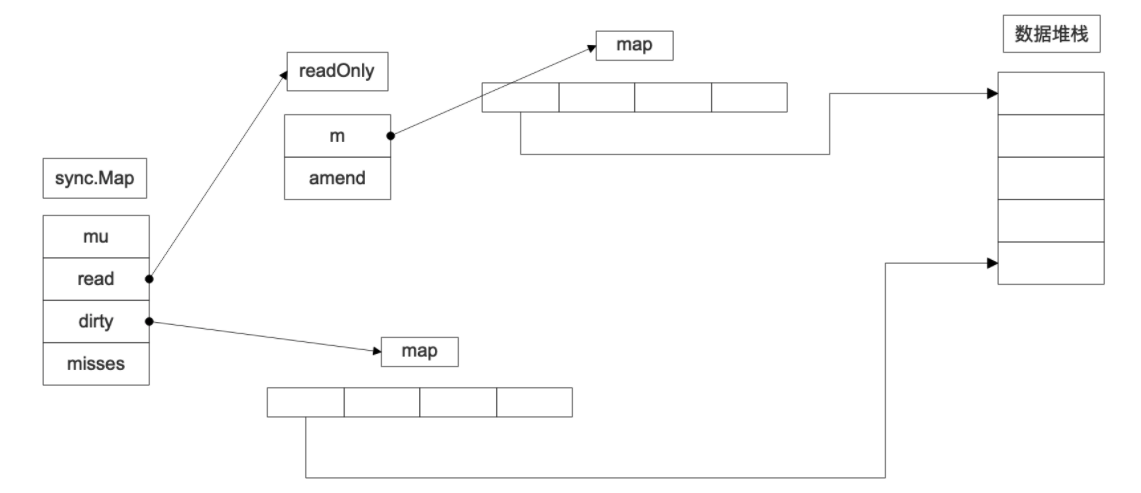
源码分析
新增key
新增一个key value,通过Store方法来实现
1
2
3
4
5
6
7
8
9
10
11
12
13
14
15
16
17
18
19
20
21
22
23
24
25
26
27
28
29
30
31
32
33
func (m *Map) Store(key, value interface{}) {
read, _ := m.read.Load().(readOnly)
// 如果这个key存在,通过tryStore更新
if e, ok := read.m[key]; ok && e.tryStore(&value) {
return
}
// 走到这里有两种情况,1. key不存在 2. key对应的值被标记为expunged,read中的entry拷贝到dirty时,会将key标记为expunged,需要手动解锁
m.mu.Lock()
read, _ = m.read.Load().(readOnly)
if e, ok := read.m[key]; ok {
// 第二种情况,先解锁,然后添加到dirty
if e.unexpungeLocked() {
// The entry was previously expunged, which implies that there is a
// non-nil dirty map and this entry is not in it.
m.dirty[key] = e
}
e.storeLocked(&value)
} else if e, ok := m.dirty[key]; ok {
// m中没有,但是dirty中存在,更新dirty中的值
e.storeLocked(&value)
} else {
// 如果amend==false,说明dirty和read是一致的,但是我们需要新加key到dirty里面,所以更新read.amended
if !read.amended {
// We're adding the first new key to the dirty map.
// Make sure it is allocated and mark the read-only map as incomplete.
// 这一步会将read中所有的key标记为 expunged
m.dirtyLocked()
m.read.Store(readOnly{m: read.m, amended: true})
}
m.dirty[key] = newEntry(value)
}
m.mu.Unlock()
}
tryLock
1
2
3
4
5
6
7
8
9
10
11
12
13
14
15
16
17
func (e *entry) tryStore(i *interface{}) bool {
p := atomic.LoadPointer(&e.p)
// 这个entry是key对应的entry,p是key对应的值,如果p被设置为expunged,不能直接更新存储
if p == expunged {
return false
}
for {
// 原子更新
if atomic.CompareAndSwapPointer(&e.p, p, unsafe.Pointer(i)) {
return true
}
p = atomic.LoadPointer(&e.p)
if p == expunged {
return false
}
}
}
tryLock会对key对应的值,进行判断,是否被设置为了expunged,这种情况下不能直接更新
dirtyLock
这里就是设置 expunged 标志的地方了,而这个函数正是将read中的数据同步到dirty的操作
1
2
3
4
5
6
7
8
9
10
11
12
13
14
15
func (m *Map) dirtyLocked() {
// dirty != nil 说明dirty在上次read同步dirty数据后,已经有了修改了,这时候read的数据不一定准确,不能同步
if m.dirty != nil {
return
}
read, _ := m.read.Load().(readOnly)
m.dirty = make(map[interface{}]*entry, len(read.m))
for k, e := range read.m {
// 这里调用tryExpungeLocked 来给entry,即key对应的值 设置标志位
if !e.tryExpungeLocked() {
m.dirty[k] = e
}
}
}
tryExpungeLocked
通过原子操作,给entry,key对应的值设置 expunged 标志
1
2
3
4
5
6
7
8
9
10
func (e *entry) tryExpungeLocked() (isExpunged bool) {
p := atomic.LoadPointer(&e.p)
for p == nil {
if atomic.CompareAndSwapPointer(&e.p, nil, expunged) {
return true
}
p = atomic.LoadPointer(&e.p)
}
return p == expunged
}
unexpungeLocked
1
2
3
func (e *entry) unexpungeLocked() (wasExpunged bool) {
return atomic.CompareAndSwapPointer(&e.p, expunged, nil)
}
根据上面分析,我们发现,在新增的时候,分为四种情况:
- key原先就存在于read中,获取key所对应内存地址,原子性修改
- key存在,但是key所对应的值被标记为 expunged,解锁,解除标记,并更新dirty中的key,与read中进行同步,然后修改key对应的值
- read中没有key,但是dirty中存在这个key,直接修改dirty中key的值
- read和dirty中都没有值,先判断自从read上次同步dirty的内容后有没有再修改过dirty的内容,没有的话,先同步read和dirty的值,然后添加新的key value到dirty上面
当出现第四种情况的时候,很容易产生一个困惑:既然read.amended == false,表示数据没有修改,为什么还要将read的数据同步到dirty里面呢?
这个答案在Load 函数里面会有答案,因为,read同步dirty的数据的时候,是直接把dirty指向map的指针交给了read.m,然后将dirty的指针设置为nil,所以,同步之后,dirty就为nil
具体的写的流程图如下:
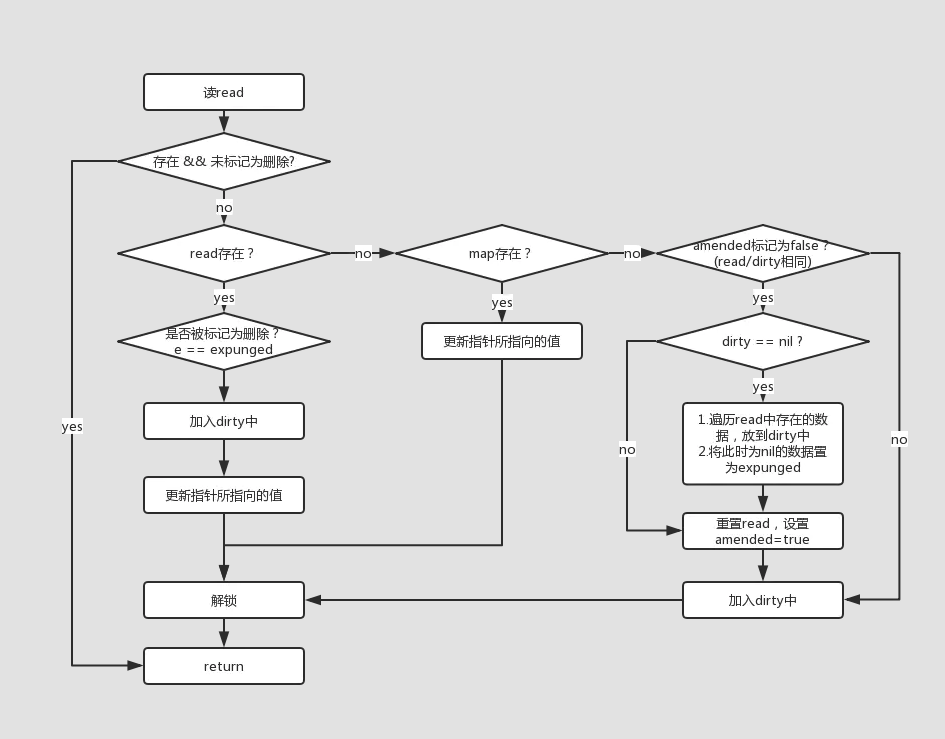
下面看看具体的实现
读取(Load)
1
2
3
4
5
6
7
8
9
10
11
12
13
14
15
16
17
18
19
20
21
22
23
24
25
26
27
28
29
30
31
32
33
34
35
36
37
38
39
func (m *Map) Load(key interface{}) (value interface{}, ok bool) {
read, _ := m.read.Load().(readOnly)
e, ok := read.m[key]
// 如果read的map中没有,且存在修改
if !ok && read.amended {
m.mu.Lock()
// Avoid reporting a spurious miss if m.dirty got promoted while we were
// blocked on m.mu. (If further loads of the same key will not miss, it's
// not worth copying the dirty map for this key.)
// 再查找一次,有可能刚刚将dirty升级为read了
read, _ = m.read.Load().(readOnly)
e, ok = read.m[key]
if !ok && read.amended {
// 如果amended 还是处于修改状态,则去dirty中查找
e, ok = m.dirty[key]
// Regardless of whether the entry was present, record a miss: this key
// will take the slow path until the dirty map is promoted to the read
// map.
// 增加misses的计数,在计数达到一定规则的时候,触发升级dirty为read
m.missLocked()
}
m.mu.Unlock()
}
// read dirty中都没有找到
if !ok {
return nil, false
}
// 找到了,通过load判断具体返回内容
return e.load()
}
func (e *entry) load() (value interface{}, ok bool) {
p := atomic.LoadPointer(&e.p)
// 如果p为nil或者expunged标识,则key不存在
if p == nil || p == expunged {
return nil, false
}
return *(*interface{})(p), true
}
为什么找到了p,但是p对应的值为nil呢?这个答案请查看解析Delete函数
missLocked
1
2
3
4
5
6
7
8
9
10
func (m *Map) missLocked() {
m.misses++
if m.misses < len(m.dirty) {
return
}
// 直接把dirty的指针给read.m,并且设置dirty为nil,这里也就是 Store 函数的最后会调用 m.dirtyLocked的原因
m.read.Store(readOnly{m: m.dirty})
m.dirty = nil
m.misses = 0
}
读取的流程图如下:
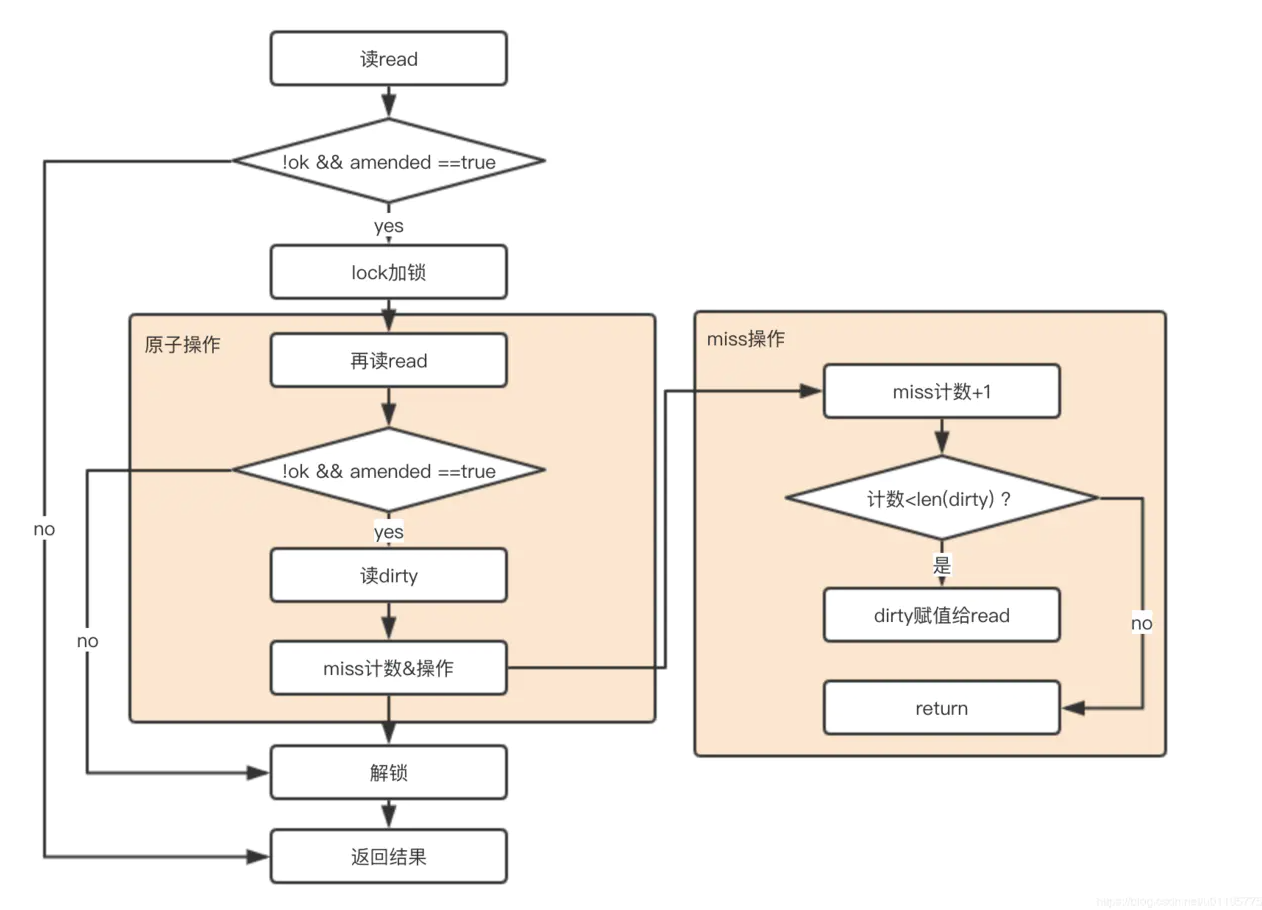
删除(Delete)
这里的删除并不是简单的将key从map中删除
1
2
3
4
5
6
7
8
9
10
11
12
13
14
15
16
17
18
19
20
21
22
23
24
25
26
27
28
29
30
31
32
33
func (m *Map) Delete(key interface{}) {
read, _ := m.read.Load().(readOnly)
e, ok := read.m[key]
// read中没有这个key,但是Map被标识修改了,那么去dirty里面看看
if !ok && read.amended {
m.mu.Lock()
read, _ = m.read.Load().(readOnly)
e, ok = read.m[key]
if !ok && read.amended {
// 调用delete删除dirty的map,delete会判断key是否存在的
delete(m.dirty, key)
}
m.mu.Unlock()
}
// 如果read中存在,则假删除
if ok {
e.delete()
}
}
func (e *entry) delete() (hadValue bool) {
for {
p := atomic.LoadPointer(&e.p)
// 已经是被删除了,不需要管了
if p == nil || p == expunged {
return false
}
// 原子性 将key的值设置为nil
if atomic.CompareAndSwapPointer(&e.p, p, nil) {
return true
}
}
}
根据上面的逻辑可以看出,删除的时候,存在以下几种情况
- read中没有,且Map存在修改,则尝试删除dirty中的map中的key
- read中没有,且Map不存在修改,那就是没有这个key,无需操作
- read中有,尝试将key对应的值设置为nil,后面读取的时候就知道被删了,因为dirty中map的值跟read的map中的值指向的都是同一个地址空间,所以,修改了read也就是修改了dirty
删除的流程图如下:
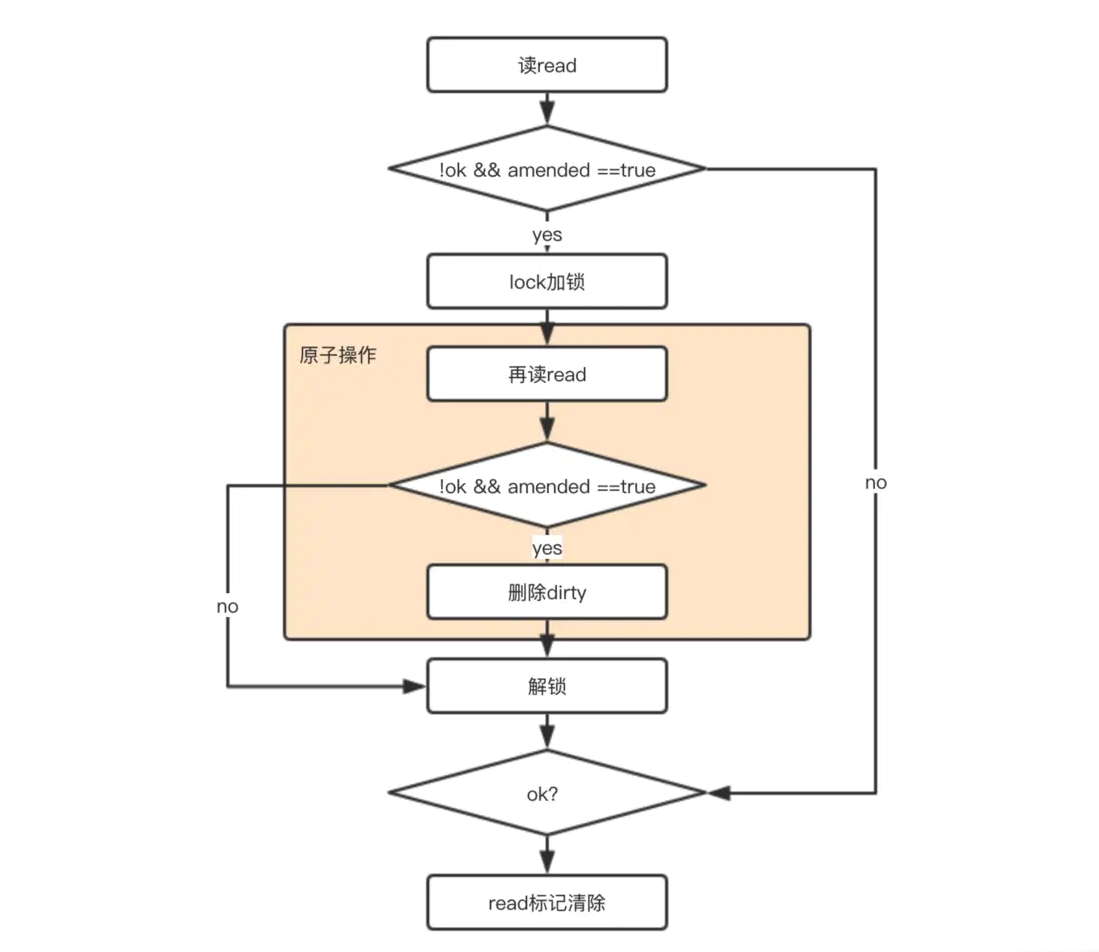
遍历(Range)
遍历的逻辑就比较简单了,Map只有两种状态,被修改过和没有修改过
修改过:将dirty的指针交给read,read就是最新的数据了,然后遍历read的map
没有修改过:遍历read的map就好了
1
2
3
4
5
6
7
8
9
10
11
12
13
14
15
16
17
18
19
20
21
22
23
24
func (m *Map) Range(f func(key, value interface{}) bool) {
read, _ := m.read.Load().(readOnly)
if read.amended {
m.mu.Lock()
read, _ = m.read.Load().(readOnly)
if read.amended {
read = readOnly{m: m.dirty}
m.read.Store(read)
m.dirty = nil
m.misses = 0
}
m.mu.Unlock()
}
for k, e := range read.m {
v, ok := e.load()
if !ok {
continue
}
if !f(k, v) {
break
}
}
}
总结:
白话文流程图一键解释sync.Map的流程:

上图还涉及到dirty复制到read等等的细小步骤没表明。
使用场景:
在官方介绍的时候,也对适用场景做了说明
The Map type is optimized for two common use cases:
(1) when the entry for a given key is only ever written once but read many times, as in caches that only grow,
(2) when multiple goroutines read, write, and overwrite entries for disjoint sets of keys.
In these two cases, use of a Map may significantly reduce lock contention compared to a Go map paired with a separate Mutex or RWMutex.
通过对源码的分析来理解一下产生这两条规则的原因:
读多写少:读多写少的环境下,都是从read的map去读取,不需要加锁,而写多读少的情况下,需要加锁,其次,存在将read数据同步到dirty的操作的可能性,大量的拷贝操作会大大的降低性能
读写不同的key:sync.Map是针对key的值的原子操作,相当于加锁加载 key上,所以,多个key的读写是可以同时并发的
网上找来了读写锁map和sync.Map的性能对比图
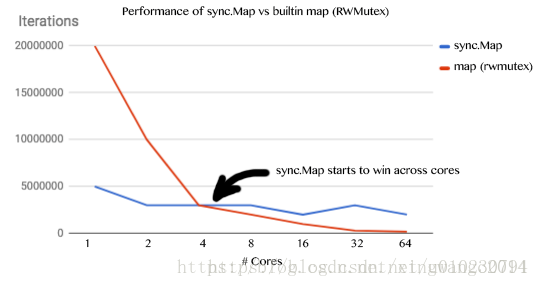
可见随着cpu核心数的增加、并发加剧,这种读写锁+map的方式性能在不停的衰减,并且在核数为4的时候出现了性能的拐点;而sync.Map虽然性能不是特别好,但是相对比较平稳。
当然,在写多读少的情况下sync.Map的性能是比不上map+RW锁的性能的,请选择使用。